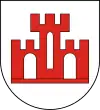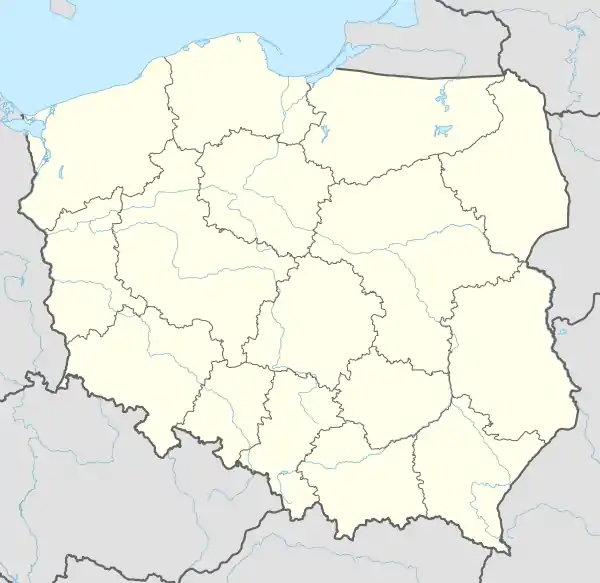Żychlin
Żychlin [ˈʐɨxlin] (other rarely used names include Zechlin and Zichlin) is a town in Kutno County, Łódź Voivodeship, Poland, about 50 north of Łódź and 90 kilometres (56 miles) west of Warsaw. It has 8,376 inhabitants (2016).[1]
Żychlin | |
|---|---|
 19th century tenement houses in the town center | |
 Flag  Coat of arms | |
 | |
 Żychlin | |
| Coordinates: 52°14′43″N 19°37′25″E | |
| Country | |
| Voivodeship | Łódź |
| County | Kutno |
| Gmina | Żychlin |
| Government | |
| • Mayor | Grzegorz Ambroziak |
| Area | |
| • Total | 8.69 km2 (3.36 sq mi) |
| Population (2016) | |
| • Total | 8,376 |
| • Density | 960/km2 (2,500/sq mi) |
| Time zone | UTC+1 (CET) |
| • Summer (DST) | UTC+2 (CEST) |
| Postal code | 99-320 |
| Website | http://www.gminazychlin.pl |
History
The village of Żychlin existed at least since 1309.[ In 1331 it was captured by the Teutonic Knights. It received city rights before 1397. Until the 19th century, the town was a private property. At the end of the Middle Ages, Żychlin was the place where away sessions of the Łęczyca town court took place.[2][3]
In the second half of the sixteenth century, the city suffered from a major fire disaster. The reconstruction was slow and even the privilege of fairs awarded to the king did not significantly affect the city's significant development. In 1790 Żychlin had 350 inhabitants and 68 houses.[2][3]
In the nineteenth century, era of the partitions, with the town finding itself in the Russian one, the population of the city increased significantly. Just as in nearby Kutno, the majority of residents were Jews. In 1870, due to the Tsarist decree, Żychlin lost its city rights due to the towns support for the January Uprising. At the end of the 19th century, the city had over 4,500 inhabitants.[2][3]
1921 saw the creation of electric plants by Zygmunt Okoniewski. Over time, due to the new electromechanical plant, the city grew and gained importance among the surrounding towns. In 1924 Żychlin regained its municipal rights.[2][3]
World War II
During World War II, the city suffered great losses, mainly among the civilian population - almost 40% of the city's population. During the war campaign of the September campaign, there were field hospitals in the city and in the Dobrzelin village, often bombarded by German air force. Numerous Polish soldiers are buried in the military quarters at the local parish cemetery and the parish cemetery in the village of Śleszyn and the military in Dobrzelin.
In the eve of World War II population of Zychlin reached 6000 people, of whom 3500 were Jewish, the rest Polish and German. In 1939 it was annexed by Nazi Germany to Wartheland. German beatings and harassment of Jews began when the Germans arrived in September 1939. The Germans confiscated Jewish business and property and Polish farms and turned them over to ethnic Germans who had been resettled in the town. Jews were brought to Żychlin from surrounding areas. In April 1940, the Germans arrested both Christian and Jewish members of the intelligentsia, especially teachers, and sent them to concentration camps. Later in 1940, Jews were moved to an overcrowded ghetto where many of the inhabitants had no means of support. During late 1941, hundreds of Jewish workers were sent to labor camps in the Poznań area. In 1942, murders of Jews began in large scale through public executions in the ghetto and at the Jewish cemetery. In March 1942, the remaining 3200 Jews were rounded up, beaten and robbed, and taken to the killing camp in Chełmno where they were immediately murdered. Perhaps 25-50 of Żychlin's Jews survived, most were those who had been sent away to labor camps, those who had fled to the Soviet Union, and some who hid.[4]
Hasidism in Zychlin
The founder of the Żychlin Hasidic dynasty Rabbi Shmuel Abba was born to Reb Zelig on the 19th of Kislev in the city of Luvitch. The first Rebbe of Zychlin, was Rabbi Shmuel Abba who had a small following of Hasidim and lived at his father-in-law's house. When he moved to Zychlin for monetary reasons he acquired a larger following. He was known as a miracle worker. He spent time in jail because his detractors were upset that he practiced practical Kabbalah.
Ninety-five percent of Zychliner Hassidim perished during the Holocaust, the last Rebbes dying at the hands of the Nazis.
References
- Population. Size and Structure and Vital Statistics in Poland by Territorial Division in 2016, as of December 31 (PDF). Warszawa: Główny Urząd Statystyczny. 2017. p. 114. ISSN 2451-2087.
- Informator – Żychlin, wyd. Miejsko-Gminny Ośrodek Kultury w Żychlinie, 1991
- "Historia". Urząd Gminy w Żychlinie (in Polish). 22 April 2011. Retrieved 12 July 2020.
- Megargee, Geoffrey (2012). Encyclopedia of Camps and Ghettos. Bloomington, Indiana: University of Indiana Press. p. Volume II, 128–129. ISBN 978-0-253-35599-7.
External links
- (in Polish) Official town webpage
- (in Hebrew) Lehav Eish
- Żychlin, Poland at JewishGen
